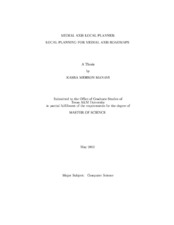| dc.contributor.advisor | Amato, Nancy M. | |
| dc.creator | Manavi, Kasra Mehron | |
| dc.date.accessioned | 2012-07-16T15:58:46Z | |
| dc.date.accessioned | 2012-07-16T20:25:23Z | |
| dc.date.available | 2012-07-16T15:58:46Z | |
| dc.date.available | 2012-07-16T20:25:23Z | |
| dc.date.created | 2012-05 | |
| dc.date.issued | 2012-07-16 | |
| dc.date.submitted | May 2012 | |
| dc.identifier.uri | https://hdl.handle.net/1969.1/ETD-TAMU-2012-05-11191 | |
| dc.description.abstract | In motion planning, high clearance paths are favorable due to their increased visibility and reduction of collision risk such as the safety of problems involving: human- robot cooperation. One popular approach to solving motion planning problems is the Probabilistic Roadman Method (PRM), which generates a graph of the free space of an environment referred to as a roadmap. In this work we describe a new approach to making high clearance paths when using PRM The medial axis is useful for this since it represents the set of points with maximal clearance and is well defined in higher dimensions. However it can only be computed exactly in workspace. Our goal is to generate roadmaps with paths following the medial axis of an environment without explicitly computing the medial axis.
One of the major steps of PRM is local planning: the planning of motion between two nearby nodes PRMs have been used to build roadmaps that have nodes on the medial axis but so far there has been no local planner method proposed for connecting these nodes on the medial axis. These types of high clearance motions are desirable and needed in many robotics applications. This work proposes Medial Axis Local Planner (MALP), a local planner which attempts to connect medial axis configurations via the medial axis. The recursive method takes a simple path between two medial axis configurations and attempts to deform the path to fit the medial axis. This deformation creates paths with high clearance and visibility properties. We have implemented this local planner and have tested it in 2D and 3D rigid body and 8D and 16D fixed base articulated linkage environments. We compare MALP with a straight-line local planner (SL), a typical local planer used in motion planning that interpolated along a line in the planning space. Our results indicate that MALP generated higher clearance paths than SL local planning. As a result, MALP found more connections and generated fewer connected components as compared to connecting the same nodes using SL connections. Using MALP connects noes on the medial axis, increasing the overall clearance of the roadmap generated. | en |
| dc.format.mimetype | application/pdf | |
| dc.language.iso | en_US | |
| dc.subject | motion planning | en |
| dc.subject | medial axis | en |
| dc.subject | path deformation | en |
| dc.title | Medial Axis Local Planner: Local Planning for Medial Axis Roadmaps | en |
| dc.type | Thesis | en |
| thesis.degree.department | Computer Science and Engineering | en |
| thesis.degree.discipline | Computer Science | en |
| thesis.degree.grantor | Texas A&M University | en |
| thesis.degree.name | Master of Science | en |
| thesis.degree.level | Masters | en |
| dc.contributor.committeeMember | Chakravorty, Suman | |
| dc.contributor.committeeMember | Song, Dezhen | |
| dc.type.genre | thesis | en |
| dc.type.material | text | en |


